![]()
![]()
![]()
Use LEFT and RIGHT arrow keys to navigate between flashcards;
Use UP and DOWN arrow keys to flip the card;
H to show hint;
A reads text to speech;
27 Cards in this Set
- Front
- Back
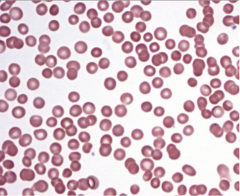
A 26 year old white man presents to the physician with anemia. His grandfather, father, and sister have similar symptoms, which have been attributed to an inherited genetic mutation. Ther peripheral blood smear is show in the image.
which of the following other findings would most likely be expected ? |
Spherocytosis can be distinguished from other causes of anemia by increase in MCHC, and increased RBC osmotic fragility.
Hereditary spherocytosis is an autosomal dominant inherited anemia caused by defects in genes coding for spectrin, ankyrin, and other RBC membrane structural proteins. The RBCs on smear will look small, round, with no central pallor. |
|
|
A 28 year old African American man presents with pallor, juandice, and dark urine 2 days after starting primaquine for his upcoming trip to sub aharan Africa. He recalls an older brother having a similar episode prior to his trip to the same region, but not his two sisters. Laboratory tests show:
WBC count: 8400/mm3 Hemoglobin: 12 g/dL Hematocrit: 36% Platelet count: 289,000/mm3
Production of which of the following molecules is decreased in this condition? |
G6PD deficiency. G6PD is an enzyme in hexose monophosphate shunt. It reduces NADP+ to NADPH, which in turn reduces glutathione(GSSG) to GSH via glutathione reductase. GSH protects against oxidant injury by reducing compounds such as hydrogen peroxide (h2O2) to water. G6PD deficiency are susceptible to hemolytic anemia in states of oxidative stress, succh as those cuased by infections, certain foods (fava beans), and drugs (primaquine, chloroquine, sulfonamides, nitrofurantoins, and others)
G6PD deficiency results in reduced levels of NADPH |
|
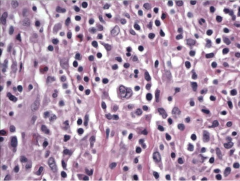
A young woman comes to her primary care physician complaining of 8 weeks of fevers, chills, night sweats, fatigue, and weight loss. About 3 weeks ago she noticed a large bump around her clavicle. The mass is surgically removed, and a biopsy specimen, shown in the image, is sent to pathology.
What is the best treatment for this patient's most likely illness?
|
Reed-Sternberg (RS) cell - binucleated cell with prominent nucleoli. -> Hodgkin's lymphoma, affects young adults, especially men, and presents with fever, night sweats, and weight loss. inc. RS cells correlate with a progressively poorer prognosis. Vincristine, a microtubule inhibitor, is especially effective in the treatment of Hodgkin's lymphoma. Other drugs include vinblastine, bleomycin, and doxorubicin.
RS cells in differing numbers are found in the different forms of Hodgkin's lymphoma. The severity of the disease variant is directly proportional to this number of these cells. |
|
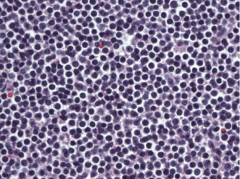
After living abroad in Africa for a number of years, a 56-year-old man is seen by his physician because of complaints of fatigue, weight loss, and anrexia. On physical examination, the patient has generalized lymphadenopathy and splenomegaly. Results of a lymph node biopsy are shown in the image.
What is the most likely diagnosis? |
Small lymphocytic lymphoma (SLL), which is the solid tumor component of chroic lymphocytic leukemia (CLL) - defacement of the lymph node architecture and diffuse replacement by small lymphocytes with slightly irregular nuclei. Prolymphocytes, larger, gather together to form proliferation centers called pseudofollicles is pathognomonic for SLL-CLL. monoclonal B-lymphocyte neoplasm that affects the peripheral blood, bone marrow, and lmph nodes.
Small lymphocytic lymphoma presents on biopsy with defacement of lymph node archtecture and diffuse replacement by small lymphocytes. Prolymphocytes are pathognomonic of SLL.
|
|
|
A woman who is blood type AB marries a man with unknown blood type. In a previous marriage to a woman with type O blood, the man had four children. Two of the children were blood type O and two were blood type A.
If this man has a child with his new wife (blood type AB), what is the probability that their child will have the AB blood type? |
A and B blood types are co-dominantly expressed, whereas O is recessively expressed. Based on his first marriage, one can conclude the man has type A blood, with alleles (A,O). A child conceived by (A,O) X (A,B) has a 25% chance of being blood type AB. |
|

A 58-year-old hospitalize woman who has been complaining of dysuria develops a high fever and a sudden drop in blood pressure. The patient has petechiae and purpura, bleeding from her intravenous sites, and epistaxis. Laboratory tests show an elevated white blood cell count, low platelet count, elevated creatinine, increased prothrombin time and partial thromboplastin time, and elevated of D-dimers. A peripheral blood smear is shown in the image.
which of the following is the most likely pathophysiology of this woman's acute symptoms? |
gram-negatiev sepsis from hospital-acquired urinary tract infection, malignancy, acute pancreatitis, trauma, transfusion reactions, and obstetric complications leads to Disseminated intravascular coagulation (DIC). DIC -> activation of the coagulation cascade, which leads to microthrombi and global consumption of platelets, fibrin, and coagulation factors. throbus formation in the microvasculature results in microangiopathy with schistocytes and helmet-shaped cells, which are indicated by the arrows in the image. Complications include bleeding, thrombosis, and organ failure. laboratory findings include elevated prothrombin time, elevated partial thromboplastin time, elevated D-dimer level, and decreased platelet count.
Laboratory findings of DIC include elevted prothrombin time, elevated partial thromboplastin time, elevated D-dimer level, and decreased platelet count. |
|
|
A 20 year old man has a history of profuse night sweats, fever, weight loss, and enlarged lymph nodes in his neck, chest, and armpits. Laboratory findings are normal except for a WBC count of 20,000/mm3. Results of lymph node biopsy reveal a malignant neoplasm containing a large number of cells with dark-staining nuclei and little cytoplasm, as well as few binucleate giant cells with eosinophilic inclusion-like nucleoli. Neither collagen banding nor lacunar cells i s present.
Which of the following is the most likely diagnosis? |
Hodgkin lymphoma typically presents with symptoms of fever, night sweats, an weight loss. RS cells are of B-cell origin and are positive for the CD15 and CD30 antigens. Lymphocyte-rich Hodgkin lymphoma is one of two variants associated with low levels of RS cells. the disease usually presents in young male and characterized by very high lymphocyte counts, low levels of RS cells, and lack of areas of collagen banding or lacunar cells. association with Epstein-Barr virus infection in approximately 40% of cases.
In Hodgkin lymphoma, the more RS cells, the worse the prognosis. Lymphocyte-rich is a subtype of Hodgkin lymphoma and is characterized by few RS cells and numerous lymphocytes. |
|
|
A given hemoglobin curve is shifted to the left
What could explain this shift |
Increased carboxyhemoglobin levels. A left shift = increase in oxygen affinity. A left shift can be seen with inc. fetal hemoglobin, decreased 2,3-DPG, dec. temp, inc. ph, increase in carbon dioxide. Exposure to carbon monoxide leads to an allosteric change and reduce oxygen offloading -> left shift curve.
exposure to carbon monoxide converts hemoglobin to carboxyhemoglobin, causing a left shift. |
|
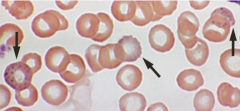
A 3 year old girl presents to the emergency department with 2 weeks of abdominal pain. The mother denies any nausea, vomiting, or fever in the child. The child says that her hands feel "funny", and she apparently has been stumblng while walking more frequently over the past few months. Serum lab. tests are normal. The child's peripheral blood smear, shown in the image, reveals stippling of RBCs.
Poisoning with which of the following substances is most likely? |
Lead. lead poisoning begin at blood lead levels of only 10ug/dL
Lead poisoning manifests with abdominal pain, peripheral neuropathy, basophilic RBC stippling, lead lines on the gingiva, and cognitive impairment. |
|
|
A 45 year old Russian woman presents to the emergency department complaining of increasing fatigue, easy bruising, and malaise. Physical examination reveals multiple foci of bruising and pale conjunctivae. A detailed history reveals that she started feeling ill several days after taking an unknown antibiotic in Russia for skin infection.
Which antibiotic is responsible for this patient's illness
|
Chloramphenicol. all classic signs and symptoms of aplastic anemia, which suppress all blood cell lines: erythroid, myeloid, and thrombocytes. this results in anemia, neutropenia, and thrombocytopenia -> fatigue, predisposition to infection, and excessive bleeding, respectively.
Aplastic anemia is characterized by hypoactive bone marrow, leading to decreased erythrocyte, neutrophil, and platelet production. Multiple causes exist, including radiation, chloramphenicol, viral infection, and chemotherapeutic drugs.
|
|
|
A 48 year old woman of mediterranean descent presents because of fatigue, arthralgias, discomfort in her right upper abdominal quadrant, and polyuria. laboratory tests are remarkable for elevated glucose level, elevated bilirubin, low hemoglobin, elevated reticulocytes, and increased transferrin saturation. Cardiac testing shows moderate restrictive cardiomyopathy. She frequently has required blood transfusions throughout her life
Which hereditary disorder does this patient most likely have ? |
beta-thalassemia major. Severe hemolysis and ineffective erythropoiesis. These individuals are transfusion dependent and frequently develop iron overload. These manifestations are due to iron deposition in various tisues including the pancreas, heart, and skin.
beta-thalassemia major is the most severe form of beta-thalassemia, inwhich the beta-chain is absent. It is more common among Mediterranean populations, whereas alpha-thalassemia is more commo among Asian and African populations. |
|
|
A 25 year old man presents to the emergency department with right lower quadrant abdominal pain, rebound tenderness, and a fever of 38C. Acute appendicitis is diagnosed and the patient undergoes appendectomy without any immediate complications. Two days after surgery his fever has diminished to 37.1C and he is discharged. Three days later, however, he returns to the hospital after experiencing an incidence of syncope. His temperature is now 38.9C and his blood pressure is 85/60 mm Hg. Physical examination is notable for a sunburn-like rash present around his abdominal sutures and on his palms. Petechiae are noted on his oral mucosa. Laboratory tests show:
WBC count: 15,000/mm3 with bands Hemoglobin: 16.5 g/mL Hematocrit: 48% platelet count: 85,000/mm3 Blood urea nitrogen: 40 mg/dL Aspartate aminotransferase: 95 U/L Prothrombin time: 13 seconds Partial thromboplastin time: 27 seconds
tests for schistocytes and fibrin split products are negative.
Which of the following is the most likely diagnosis?
|
Staphylococcal toxic shock syndrome - fever, hypotension (common cause of syncope), dermatologic manifestations, and multisystem organ involvement. At least three of the following organ systems are typically involved: gastrointestinal (nausea/vomiting); muscular (myalgia with elevated creatine phosphokinase level); renal (elevated serum blood urea nitrogen and/or creatinine levels, or pyuria); hepatic(elevated aspartate aminotransferase, alanine aminotransferase, and/or bilirubin); hematologic(platelet count <100,000/mm3, leukocytosis); or central nervous system(altered mentation/consciousness without focal findings). Although toxic shock syndrome often is associaated with tampons used during menstruation, surgical wound infections are another prominent cause.
staphylococcal toxic shock syndrome, caused by the massive cytokine release in response to exotowin, may manifest systemically as fever and hypotension and involve multiple organ systems; palmar/plantar desquamation is a hallmark feature, but it does not occur until approximately 2 weeks after onset. |
|
|
A 17 year old girl was recently prescribed sulfamethoxazole and trimethoprim for urinary tract infection. The patient calls the physician's office 3 days later complaining of fatigue, darkening urine, and a yellow tinge to her skin and sclera. ther physician suspects that the patient has a glucose 6 phosphate dehydrogenase deficiency.
Which compound builds up because of this deficiency? |
Oxidized glutathione
G6PD catalyzes NADP to its reduced form (NADPH). In patients with G6PD deficiency, NADPH levels are too low to maintain glutathione in a reduced state during oxidative stress; the result is oxidant build-up, which damages hemoglobin. |
|
|
A 36 year old white woman with a history of uncomplicated systemic lupus erythematosus presents to her physician with edema and pain in her right foot that began 2 days ago. physical examination reveals a positive Homan's sign (pain on dorsiflexion of the foot), and an ultrasound reveals a nonocclusive thrombus in the right popliteal vein. Laboratory studies show a platelet count of 175,000/mm3, a prothrombin time of 14 seconds, and partial thromboplastin time of 89 seconds.
What is the most likely cause of this patient's condition? |
Antibodies directed against platelet phospholipids. lupus anticoagulant/acquired antiphospholipid antibody syndrome. Platelet phospholipids are required for clotting pathways and antibodies made them accessible to clotting factors leading to venous/arterial thrombosis. Partial thromboplastin time assays use exogenous phospholiids, the antibodies inhibit their function and show an increase in coagulation time.
Antiphospholipid antibody syndrome, or lupus anticoagulant, is a result of antibodies directed against platelet phospholipids, causing an increase in coagulation time.
|
|
|
A 70 year old man with hyperlipidemia and hypertension presents to the emergency department because of a 1 hour history of chest pain. his ECG shows sinus tachycardia and ST-elevations in leads II, III, and aVF. He is started on a medication to block the aggregation of platelets and is scheduled for imminent percutaneous coronary intervention (PCI).
Administering abciximab would most closely mimic which of the following diseases? |
Glanzmann's thrombasthenia is a platelet disorder due to decreased glycoproteins (Gp) IIb/IIIa, which are involved in platelet-to-platelet aggregtion. Blockade of Gps IIb/IIIa by abciximab leads to a state of decreased platelet aggregation similar to Glanzmann's thrombasthenia, which would be beneficial in this patients.
The Gps IIb/IIIa are responsible for platelet-platelet aggregation. These glycoproteins are targeted by abciximab, which is derived from the Fab fragment of anti-GpIIb/IIIa antibodies. The drugs ticlopidine and clopidogrel block the expression of Gps IIb/IIIa through blockade of the adenosine phosphate receptor. Patients with acute myocardial infarction benefit from receiving abciximab in advance of PCI.
|
|
|
A 19 year old man presents with a week history of fever, weakness, and fatigue. Physical examination shows loss of muscle strength, pale conjunctiva, and petechiae spread diffusely across his trunk. CT scan demonstrates a large mediastinal mass. A bone marrow biopsy reveals the presence of blast cells in the bone marrow.
which of the following is the most likely diagnosis? |
Lymphoblastic lymphoma typically present in children and adolescents with leukemia and a mediastinal mass. it has an immature T-lymphocyte phenotype and found in the bone marrow.
Lymphoblastic lymphoma is a form of non-Hodgkin's lymphoma diagnosed by lymphoblastic proliferation in the bone marrow and the presence of a mediastinal mass. |
|
|
In the emergency department a 38 year old man complains of shortness of breath and lethargy of 6 months' duration. On examination his lungs are clear to auscultation bilaterally, capillary refill time is >5 seconds, and he has conjunctival pallor with slightly icteric sclera. A complet blood cell count shows a WBC of 6700/mm3, hemoglobin of 5.3g/dL, hematocrit of 17.9%, and a platelet count of 245,000/mm3. He also has an elevated reticulocyte count, lactate dehydrogenase and total bilirubin levels and a low serum haptoglobin level. Coagulation studies are within normal limits and a direct coombs' test returns positive.
What is the most likely etiology? |
Autoimmune hemolytic anemia is one of the most common causes of acquired hemolytic anemia. It is diagnosed by the detection of antibodies against the patient's RBCs via the direct Coombs test. This patient has typical lab values of hemolytic anemia, including elevated LDH, increased indirect bilirubin, and low haptoglobin levels. Autoimmune hemolytic anemia can be idiopathic, viral induced, SLE-induced, and a result of lymphomas.
autoimmune hemolytic anemia is diagnosed with a direct Coombs test showing antibodies to the patient's RBCs. It is associated with elevated LDH and indirect bilirubin and low haptoglobin levels. |
|
|
A 12 year old girl is being treated with cyclophosphamide for juvenile rheumatoid arthritis. she is taking the standard dose of cyclophosphamide and appears to be supersensitive to its adverse effects, quickly developing hemorrhagic cystitis. On physical examination her pediatrician notices scattered petechiae over the child's body. The doctor also learns that both her paternal uncle and her mother's aunt were diagnosed at a young age with bone problem.
Which of the following is most likely to manifest with this patint's symptoms.
|
Fanconi's anemia is an autosomal recessive disorder that results in marrow hypofunction and, eventually, pancytopenia. evident early in life and accompanied multiple congenital abnormalities, including hypoplastic bone anomalies. The hallmark of FA is inc. chromosomal breakage in response to DNA-damaging agents, due to a defect in a multiprotein complex that is required for homologous recombination DNA repair. more sensitive to cyclophosphamide and other chemotherapy/radiation when receiving treatment for disorders such as arthritis. Also increase risk of developing myelodysplastic syndrome (5%) and acute myloid leukemia (10%).
FA presents with marrows hypofunction leading to pancytopenia. It is due to increased chromosomal breakage caused by a defect in a multiprotein complex required for repair, and makes patients more sensitive to chemotherapy and radiation. |
|
|
A 32 year old man presents to his primary care physician with an enlarged lymph node in his neck. Biopsy shows a predominance of lymphocytes, granulocytes, and plasma cells with occasional binucleated cells clearly identifiable as Reed-Sternberg cells. He is diagnosed with Hodgkin's lymphoma and is started on a chemotherapy regiment that includes the synthetic corticosteroid prednisone.
Which of the following is the active form of prednisone? |
Prednisolone. anti-inflammatory. The enzyme that catalyzes this reaction is 11-beta-hydroxysteroid dehydrogenase.
Prodrugs must be converted to their active metabolites before they can have their effect. In this case, prednisone is metabolized to prednisolone, the active form of the drug. |
|
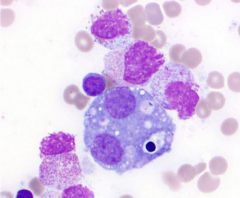
a 2 year old is brought to the emergency department because of fevers that have been occurring daily for 3 weeks Physical examination reveals a 1.2kg weight loss since her last doctor's visit 1 month earlier. She also has pallor, hepatomegaly, and splenomegaly. She is admitted to the hospital and undergoes bone marrow aspiration. Results are shown in the image.
Which of the following is the most likely diagnosis ? |
Hemophagocytic lymphohistiocytosis.
Hemophagocytic lymphohistiocytosis can be identified on a bone marrow smear by looking for macrophages engulfing RBCs. Treatment involves etoposide, methotrexate, and corticosteriods.
|
|
|
A 76 year old man presents to the emergency department with a 3 day history of constipation. He reports fatigue and changes in bowel habits over the period of a year, including dark stools. On physical examination the patient's abdomen is remarkably distended. Barium enema reveals an apple-core lesion of the rectosignmoid junction, and biopsy demonstrates adenocarcinoma. Laboratory studies show:
WBC count: 10,200/mm3 Hemoglobin: 8.8 g/dL Hematocrit: 26.5% Platelet count: 231,000/mm3
The patient's low hematocrit likely reveals what type of anemia?
|
Microcytic anemia. gastrointestinal blood loss 0> carcinoma of the colon -> iron deficiency anemia -> hypochromic microcytic anemia.
Carcinoma of the colon can manifest with fatigue, changes in bowels, distended abdomen, and dark stools from internal bleeding, which can result in iron-deficiency microcytic anemia. |
|
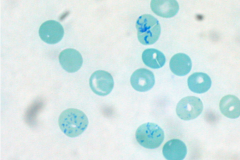
The patient's perpheral blood smear shown in the image includes RBCs that are smaller than normal with a bluish tinit and a lack of central pallor, in addition to some larger, immature RBCs.
Which of the following diseases is most likely to cause this finding. |
Hereditary spherocytosis results in small RBCs with abundant reticulocytes. increased reticulocyte count is seen in response to blood loss or hemolytic anemias such as hereditary spherocytosis. a low reticulocyte count is seen in hypoproliferative anemias.
Small RBCs, some with bluish tint, irregular borders, and lack of central pallor, are reticulocytes. They appear in hereditary spherocytosis and other hemolytic anemias, n response to blood loss. |
|
|
In the setting of an acute myocardial infarction, a patent vessel lumen must be re-created so that sufficient blood flow can reach the myocardium in jeopardy. However, depending on the resources available, some patients may undergo percutaneous catheterization angioplasty and others may receive intravenous drug therapy.
Which of the following most accurately describes the mechanism of action of such intravenous drugs? |
Promote the conversion of plasminogen to plasmin. Thrombolytics work direcly or indirecly assisiting the conversion of plasminogen to plasmin. Plasmin works by cleaing thrombin and fibrin clots. Evidence suggests that tPA works specifically on fibrin-bound plasminogen.
In facilities where angioplasty is not available, IV thrombolytics may be administered in the setting of acute MI tPA promotes clot breakdown by aiding conversion of plasminogen to plasmin.
|
|
|
a 30 year old woman gives birth to a boy. He has severe facial and limb malformations, as wel as neurological defects. An axial MRI of is brain is taken and is shown in the image. As her phyicians work to find the cause of her baby's malformations, the mother mentions that she took a certain medication during her pregnancy.
In light of the child's developmental defect, which of the following medication was this patient most likely given. |
warfarin
warfarin is contraindicated in pregnancy. When anticoagulation is essential in the pregnant mother, unfractionated heparin is the agent of choice. |
|
|
A 10 year old boy suffers from recurrent bacterial infections, eczema, and nosebleeds. His maternal grandfather had similar symptoms, but the boy's mother does not. They boy's platelet count is 60,000/mm3.
what are the odds that his brother will be affected by the same disorder ? |
50%
Wiskott-Aldrich syndrome is an X-linked recessive disorder characterized by recurrent pyogenic infections, thrombocytopenia, purpura, and eczema.
|
|
|
An 8 year old boy comes to the clinic for a routine visit with his pediatrician. the child has short stature, polydactyly, radial hypoplasia, small testicles, and kidney malformations. The patient's mother reports that her son is easily fatigued and suffers from frequent nosebleeds. Lab studies show pancytopenia.
Which of the folowing is the correct treatment for this patient's underlying disease? |
bone marrow transplant
Fanconi's anemia is an autosomal recessive disorder in which cells are at increased susceptibility to chromosomal breakage when exposed to DNA cross-linking agents. Fanconi's anemia is clinically characterized by progressive bone marrow failure and multiple congenital anomalies, including radial hypoplasia and thumb deformity. |
|
|
A 17 year old boy presents to the emergency department with severe abdominal pain. Lab tests show a deficit in porphobilinogen deaminase and excess gamma aminolevulinate and porphobiliinogen in the urine
whch of the follow symptoms would most likely also be prsent in this pt. |
sdf |

